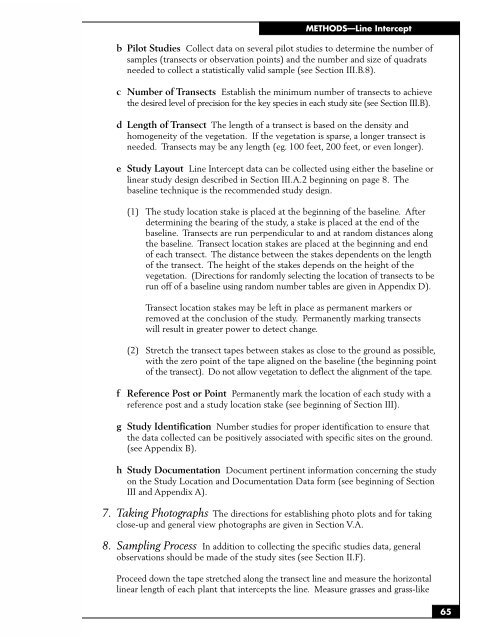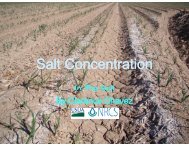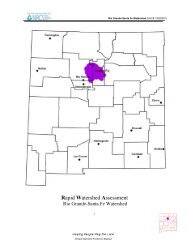SAMPLING VEGETATION ATTRIBUTES - New Mexico NRCS - US ...
SAMPLING VEGETATION ATTRIBUTES - New Mexico NRCS - US ...
SAMPLING VEGETATION ATTRIBUTES - New Mexico NRCS - US ...
Create successful ePaper yourself
Turn your PDF publications into a flip-book with our unique Google optimized e-Paper software.
METHODS—Line Intercept<br />
b Pilot Studies Collect data on several pilot studies to determine the number of<br />
samples (transects or observation points) and the number and size of quadrats<br />
needed to collect a statistically valid sample (see Section III.B.8).<br />
c Number of Transects Establish the minimum number of transects to achieve<br />
the desired level of precision for the key species in each study site (see Section III.B).<br />
d Length of Transect The length of a transect is based on the density and<br />
homogeneity of the vegetation. If the vegetation is sparse, a longer transect is<br />
needed. Transects may be any length (eg. 100 feet, 200 feet, or even longer).<br />
e Study Layout Line Intercept data can be collected using either the baseline or<br />
linear study design described in Section III.A.2 beginning on page 8. The<br />
baseline technique is the recommended study design.<br />
(1) The study location stake is placed at the beginning of the baseline. After<br />
determining the bearing of the study, a stake is placed at the end of the<br />
baseline. Transects are run perpendicular to and at random distances along<br />
the baseline. Transect location stakes are placed at the beginning and end<br />
of each transect. The distance between the stakes dependents on the length<br />
of the transect. The height of the stakes depends on the height of the<br />
vegetation. (Directions for randomly selecting the location of transects to be<br />
run off of a baseline using random number tables are given in Appendix D).<br />
Transect location stakes may be left in place as permanent markers or<br />
removed at the conclusion of the study. Permanently marking transects<br />
will result in greater power to detect change.<br />
(2) Stretch the transect tapes between stakes as close to the ground as possible,<br />
with the zero point of the tape aligned on the baseline (the beginning point<br />
of the transect). Do not allow vegetation to deflect the alignment of the tape.<br />
f Reference Post or Point Permanently mark the location of each study with a<br />
reference post and a study location stake (see beginning of Section III).<br />
g Study Identification Number studies for proper identification to ensure that<br />
the data collected can be positively associated with specific sites on the ground.<br />
(see Appendix B).<br />
h Study Documentation Document pertinent information concerning the study<br />
on the Study Location and Documentation Data form (see beginning of Section<br />
III and Appendix A).<br />
7. Taking Photographs The directions for establishing photo plots and for taking<br />
close-up and general view photographs are given in Section V.A.<br />
8. Sampling Process In addition to collecting the specific studies data, general<br />
observations should be made of the study sites (see Section II.F).<br />
Proceed down the tape stretched along the transect line and measure the horizontal<br />
linear length of each plant that intercepts the line. Measure grasses and grass-like<br />
65




